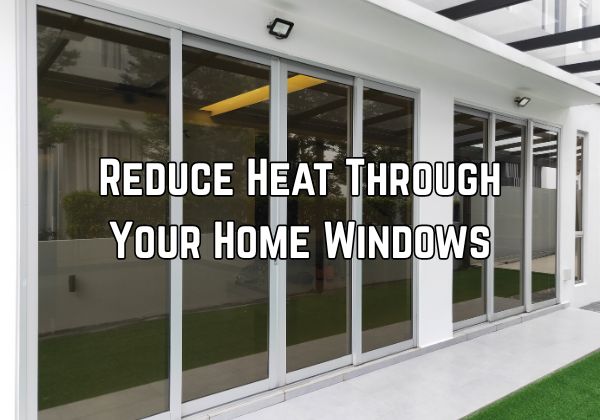Hot rooms and high energy bills often come down to one culprit, your windows.
In many homes, windows let in more heat than any other surface. This can make some rooms feel like ovens in summer, even with the AC running. The good news is, there are simple and effective ways to reduce heat transfer through your windows, without replacing them. Professional residential window film installation provides one of the most effective solutions for heat reduction in Greenville homes.
Here’s what actually works.
Key Takeaways
-
Solar heat gain through windows can drive up indoor temperatures fast.
-
Window films, shades, blinds, and glazing upgrades can all block heat.
-
Low-E coatings and insulated curtains are budget-friendly options.
-
Blocking infrared (IR) and UV rays helps reduce fading and interior damage.
-
Tinted window film is one of the best long-term solutions for hot rooms.
Why Windows Let in So Much Heat?
Windows might seem harmless, but they’re often the weakest point when it comes to insulation.
Here’s why:
| Problem | What It Does |
|---|---|
| Solar Heat Gain | Sunlight passes through glass, heating rooms. |
| Poor Insulation | Single-pane windows leak both cool air and let heat in. |
| No UV/IR Blocking | Regular glass doesn’t block infrared or UV rays. |
Solar Heat Gain Explained
Solar heat gain is when sunlight enters your home, turning into heat once it hits surfaces like floors, walls, and furniture.
Standard windows can let in up to 75% of solar heat (per the U.S. Department of Energy). This is why rooms with big windows get much hotter than the rest of the house.
Best Ways to Reduce Heat Through Windows
You don’t need a full renovation to fix this. Start with these proven heat-blocking strategies.
1. Apply Heat-Blocking Window Film
Window film is a thin layer applied to your glass that reflects heat, UV, and infrared rays. To understand how Window film works, it uses micro-layers that filter light and reduce solar heat entering your space.
There are different types of films:
-
Ceramic film: Blocks heat without darkening the glass.
-
Metalized film: Reflective and very effective, but can interfere with cell/Wi-Fi signals.
-
Dyed film: Cheaper but less durable and less effective.
Key Benefits:
-
Can block 50–80% of solar heat depending on the film type.
-
Filters out 99% of UV rays, protecting floors and furniture.
-
Keeps interiors cooler without changing your window’s appearance.
This is one of the most effective and non-invasive ways to reduce indoor heat from the sun.
2. Use Solar Shades or Roller Blinds
Solar shades are made with a special mesh that reduces glare and heat while still letting in natural light.
They’re rated by “openness”:
-
1–3% openness: Maximum heat and glare reduction.
-
5–10% openness: More natural light, less heat blocking.
These are a great daytime solution, especially for east- or west-facing windows.
3. Add Insulated Curtains or Thermal Drapes
Thermal curtains have extra padding to block heat. Look for:
-
Multiple layers (including foam or mylar lining).
-
Blackout capabilities, which also help with privacy.
They work best when closed during the hottest parts of the day. Even at night, they help keep the cool air inside.
4. Install Exterior Shading Devices
Keeping heat out before it hits the glass is even better.
Options include:
-
Awnings
-
Exterior solar screens
-
Shutters
-
Pergolas with shade panels
These create shade, which reduces how much direct sunlight reaches your windows. According to the DOE, window awnings can reduce solar heat gain by up to 65% on south-facing windows and 77% on west-facing ones.
5. Upgrade to Low-E Glass or Window Glazing
If you’re planning a window replacement, consider Low-E (low emissivity) glass.
This glass has a microscopic coating that reflects infrared and UV rays. It still allows visible light through, but keeps out the heat.
For older windows, adding storm windows or glazing inserts can offer similar benefits without a full replacement.
Other Simple Ways to Keep Your Home Cooler
Here are a few more tricks that help, especially when combined with window solutions:
Use Reflective Window Panels or Inserts
These are removable panels with reflective surfaces, often used during summer to block direct sun.
Close Blinds and Curtains During Peak Sun Hours
Midday sun is the strongest. Close window treatments between 11 a.m. and 4 p.m. to trap less heat.
Use Light-Colored Window Coverings
White or light-colored blinds reflect more heat than darker shades, which tend to absorb it.
Comparison: Window Film vs Shades vs Curtains
| Feature | Window Film | Solar Shades | Insulated Curtains |
|---|---|---|---|
| Blocks Solar Heat | ✅ High (up to 80%) | ✅ Moderate | ✅ Moderate |
| Affects View | ❌ No | ✅ Partial | ✅ Yes |
| Year-Round Use | ✅ Yes | ✅ Yes | ✅ Yes |
| UV Protection | ✅ Excellent | ✅ Good | ✅ Good |
| Cost (avg per window) | $$ | $–$$ | $–$$ |
| Works Without Daily Use | ✅ Yes | ❌ No | ❌ No |
Why This Matters for Energy Bills
When you reduce heat gain through your windows, your air conditioning doesn’t have to work as hard.
The U.S. Department of Energy reports that 30% of a home’s cooling energy can be lost through windows. That’s money out the window, literally.
By treating your windows, you:
-
Lower your electric bill
-
Extend your HVAC system’s life
-
Make your home more comfortable
Final Thoughts
Reducing heat through your windows isn’t just about comfort. It also protects your home, lowers energy costs, and reduces wear on your cooling system. Window film can significantly cool your house during hot summer months.



